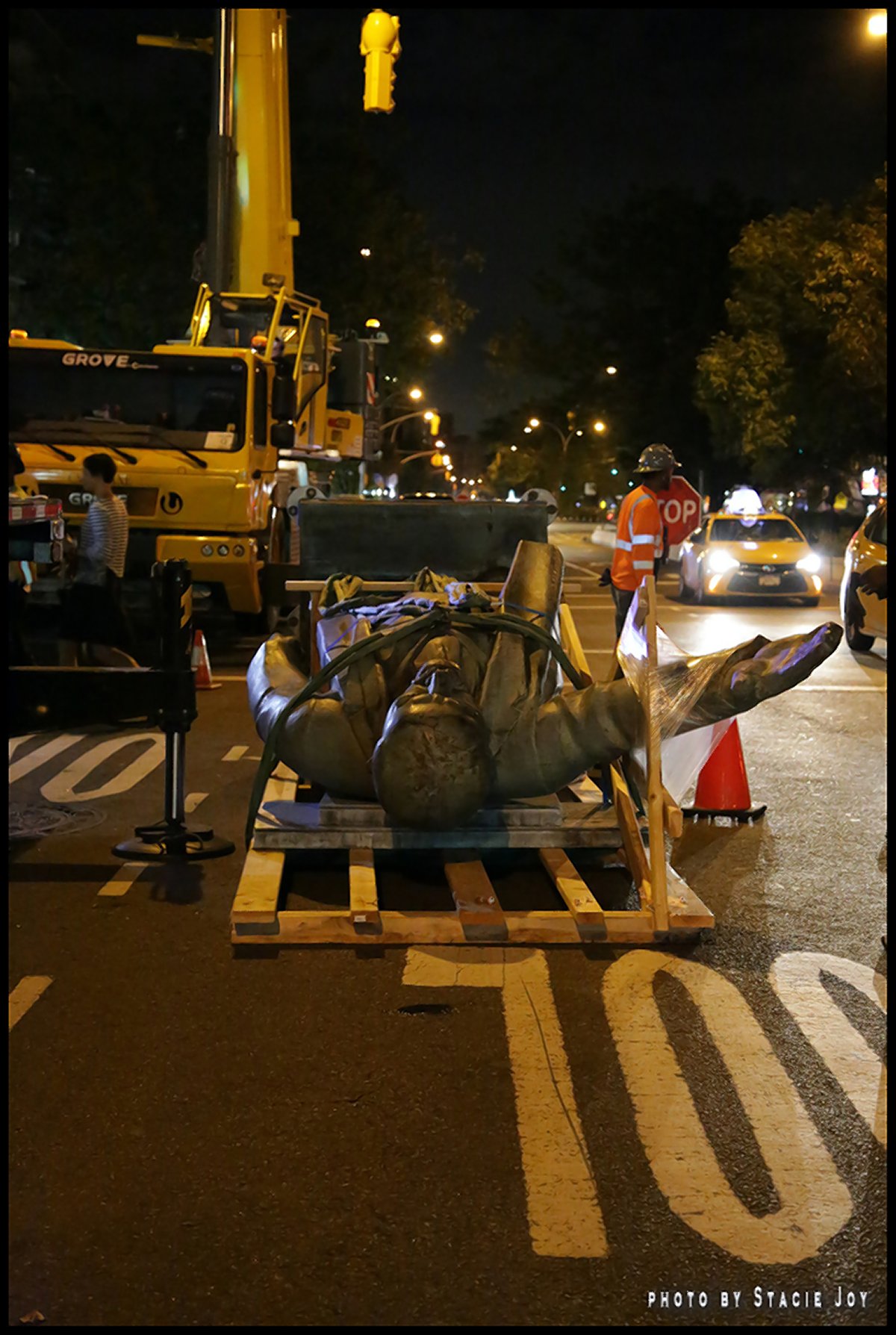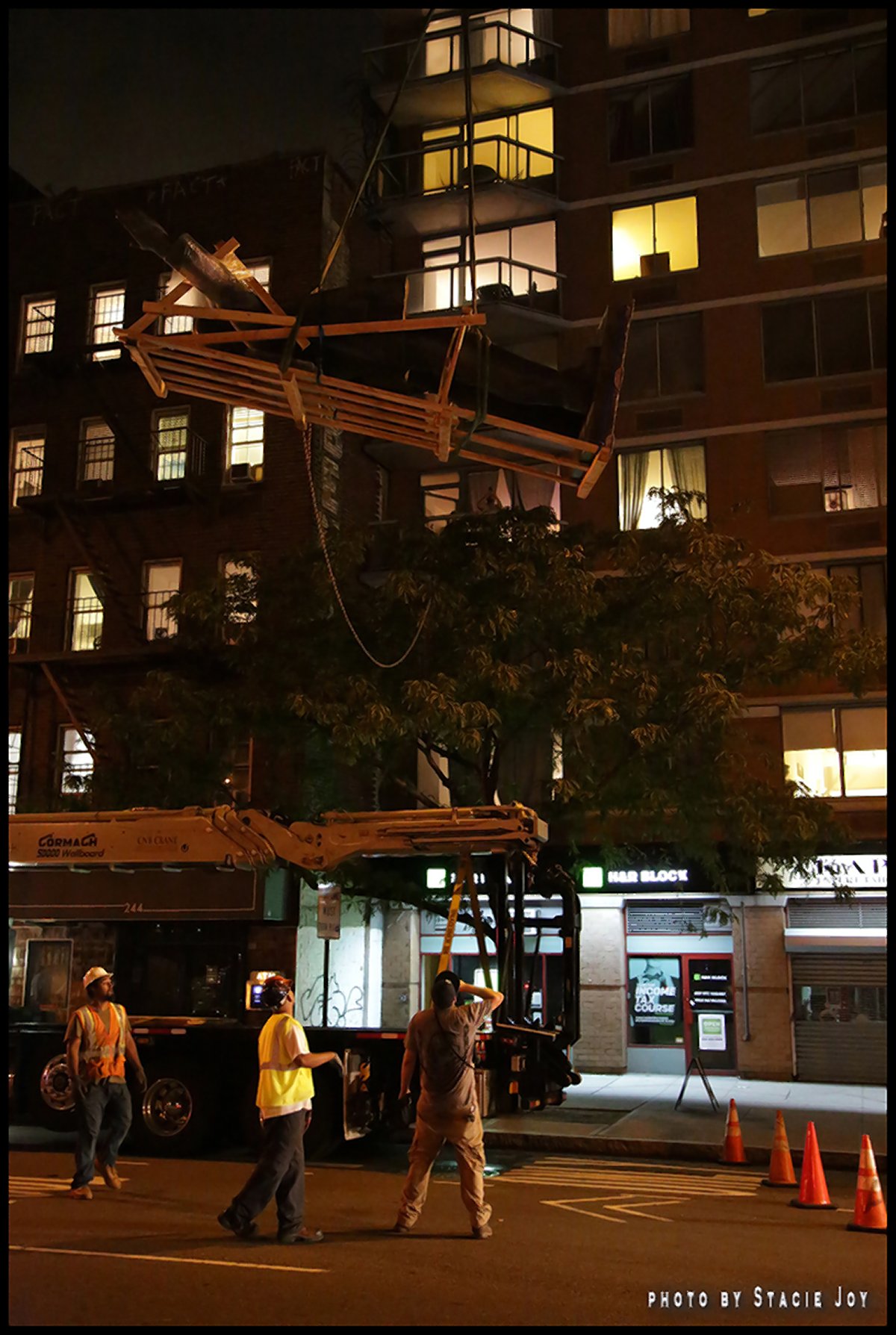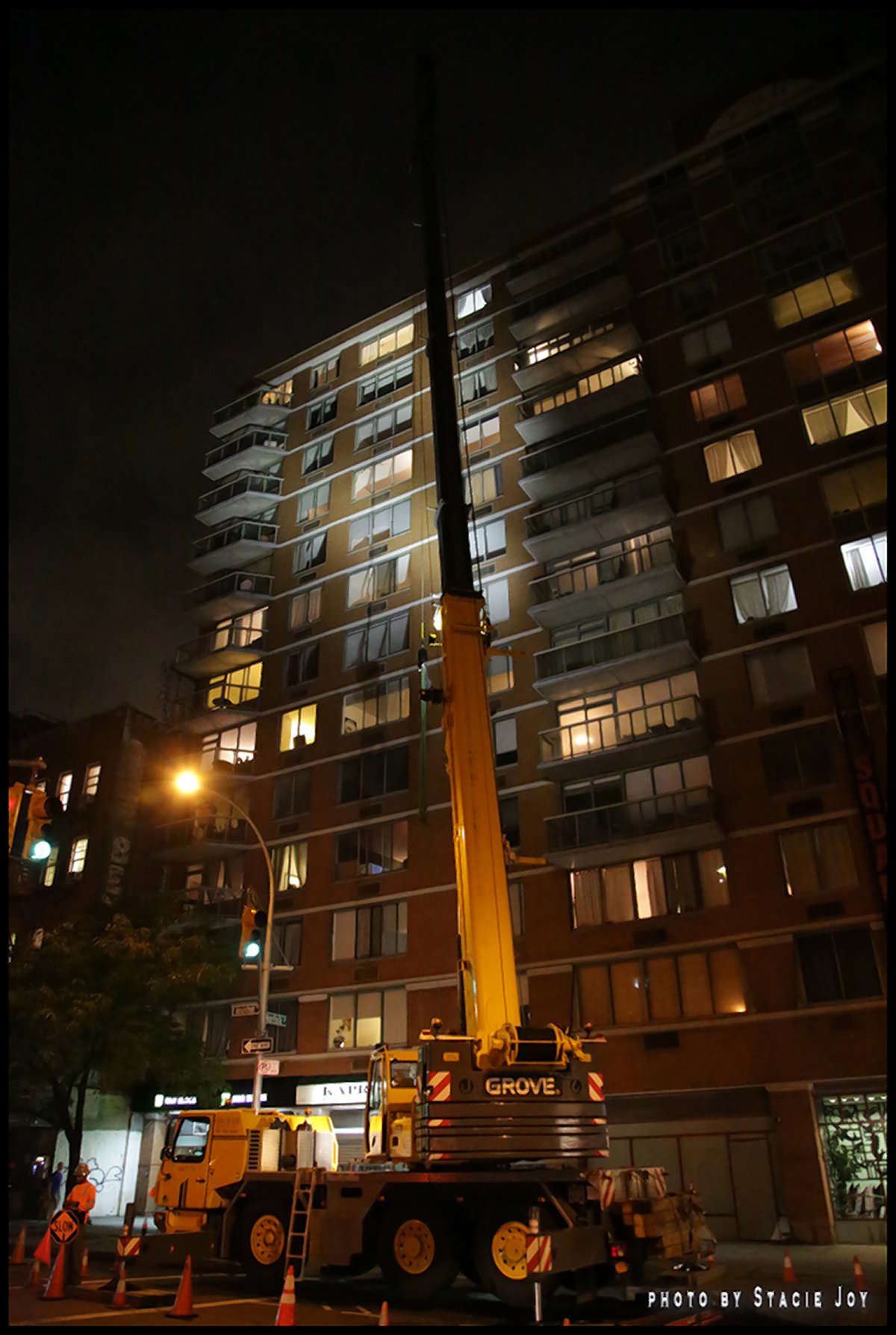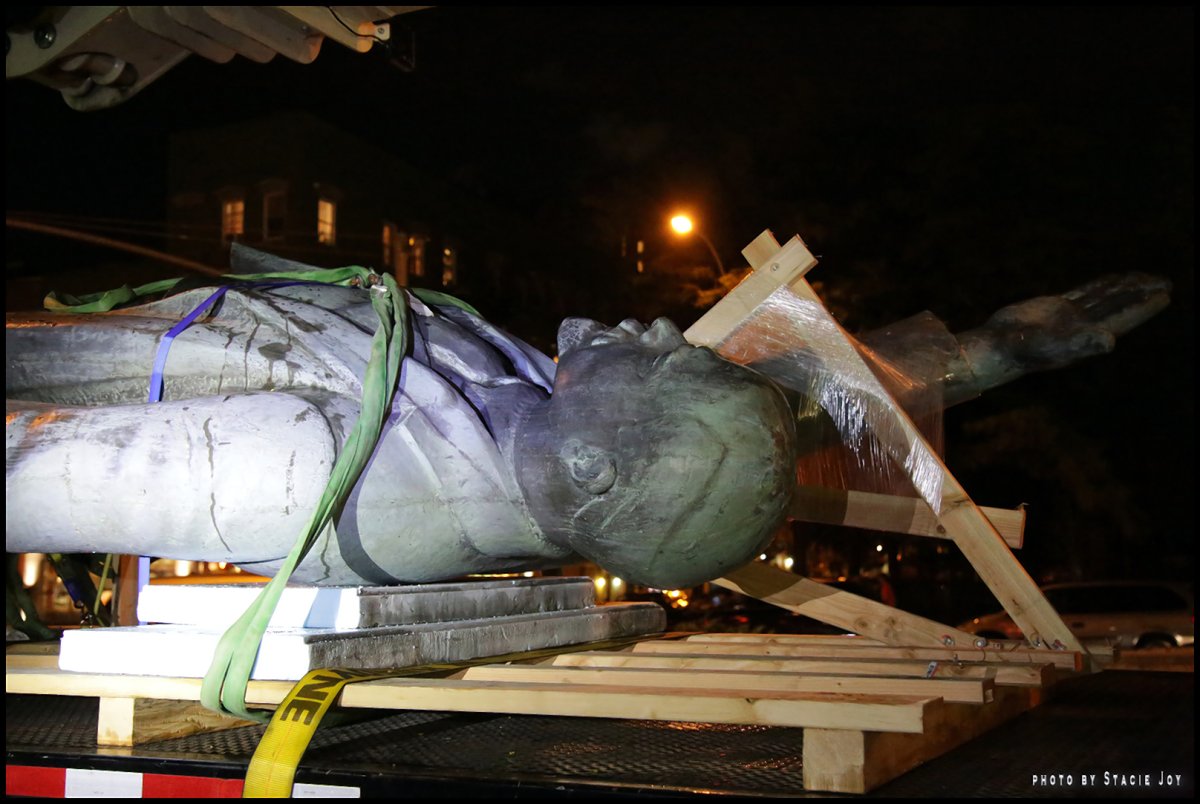
BY LINCOLN ANDERSON | Another statue of Lenin was toppled earlier this week. Well…not exactly toppled. It was lowered down gently by crane, then carted away on a flatbed truck.
There were no elated shouts of “Freedom! Freedom at last!” Several people did wonder aloud, though, what a statue of “Lennon” was doing on E. Houston St. instead of being up at The Dakota, where the famous Beatle was shot.
The iconic artwork’s removal does mark a revolution of sorts, though. No, not of the end of communism — but perhaps of the victory of gentrification in the East Village.
The Vladimir Lenin statue had stood on the roof of Red Square since being installed there in 1994. The 130-unit apartment building had opened for occupancy three years earlier, and was seen as an early beachhead of gentrification in the then-still-gritty neighborhood.
Last month, the New York Post reported that the building, at 250 E. Houston St., was in contract to be sold for $100 million.
According to a 1997 New York Times article, the statue of the renowned red leader was found in Moscow by Michael Shaoul, a co-owner of the building with Michael Rosen, the original developer.
Lenin didn’t go easily on Monday night, though. It took two two-and-a-half hours to remove him. For starters, it turned out the crane was too short to reach the roof. So the workers had to reel it back down, then bring in an extension and attach it.
A crowd of onlookers, including Red Square residents, were on hand to bid farewell to the quirky commie monument. Some were quite concerned.

At one point, people called 911 to report that a “landmarked statue was being stolen by some guys with a crane.” Ninth Precinct police responding to a traffic accident on Houston St. were called off that job and rushed over to Red Square. But the Lenin-ectomy wasn’t illegal, and the Soviet symbol wasn’t even landmarked.
“People seemed very sad at the removal of the statue,” one witness reported. “There were extended political discussions regarding communism and capitalism, and Trump versus Clinton, as well as landlord bashing.”
Rosen, a socially conscious developer, formerly lived at the Christodora House, at E. Ninth St. and Avenue B. A dozen years ago, he co-founded the East Village Community Coalition to fight developer Gregg Singer’s plan to build a supersized university dormitory on the site of the old P.S. 64, just east of Christodora. Working with former Councilmember Margarita Lopez, Rosen and E.V.C.C. miraculously got the old school landmarked, foiling the developer’s scheme.
For the past four years, Rosen has lived slightly east of the East Village, as in Vietnam — which happens to be one of the world’s five remaining communist countries. (The others are China, Cuba, Laos and North Korea.) He works there with an agriculture and food company. Before that, he was in Hong Kong for a year and a half.
In an e-mail interview with The Villager on Tuesday, Rosen filled in the details of the Loisaida Lenin’s rise and fall.
Rosen noted that, even though he developed the property, he is — and always has been — a nonvoting shareholder in 250 E. Houston St.
“So I have no say in any decisions,” he said.
“Sure of course I know that our Lenin was taken down,” he said. “Sad yes that people prefer ‘no Lenin.’
“The building might be being sold but I believe hasn’t yet been. But I guess times do change and what one generation finds compelling or intriguing isn’t to a next,” he said of the newly Lenin-less luxe residence.
“The Lenin statue was essentially my idea, supported by my partner then, Michael Shaoul, who helped deeply,” Rosen explained. “My idea was that a monument put up on the top of Red Square, waving to Wall Street, would be lovely. It was an homage to a neighborhood and city.
“Please remember,” he continued, “that the Lower East Side was a place of serious political progressive-to-radical focus only as far back as, for example, Frances Goldin’s time as a younger woman, when she ran on an election ticket with W.E.B. DuBois under the Communist Party. Frances said so.”
He was referring to the legendary Cooper Square housing activist and longtime literary agent.

“I believe that the building adjoining or just south of Trinity Lutheran Church, on Avenue B, was once the office of the Communist Party,” Rosen added. “My Great-uncle Harry, a hot-typesetter for The New York Times when there still was such a thing, said there used to be socialist or communist worker rallies in the small park just north of the old Forward building. Not to mention the I.W.U., etc., etc., grown in the earth of New York.”
“So it’s not that I admire Mr. Lenin, but that the statue of Lenin is a world-known symbol of a time in world history where issues of justice, of social promise, were prominent.”
Yet, Rosen noted, Lenin had his flaws, from his bourgeois taste for fine French pastries to “his apparent brutal suppression of many.”
As for himself, Rosen said he is simply a “good-hearted realist” who has always voted Democrat.
He was e-mailing while riding in a car on his way home from work.
“I have just now, as I type, passed another stature of Lenin here in Hanoi,” he noted.
Rosen explained that he is in Vietnam because he was offered a job by an investment group there looking to transform their company.
“Vietnam has a creative aspect feeling very similar in ways to what the Lower East Side was back some decades ago,” he said. “Given various family realities, I felt a need to exile myself. I could have moved to Brooklyn, and Brooklyn is great, but I had an invitation to here.”
Actually, it was the E. Houston Lenin that originally led him to Vietnam, he said. Basically, he liked it so much, he wanted to add a second red revolutionary atop Red Square, creating a veritable Marxist menagerie.
“In 1996, I had the idea of finding a Ho Chi Minh statue from Vietnam, to hoist it to the top of Red Square waving to Harlem, where legend has it that Ho Chi Minh worked as a short-order cook and perhaps studied a bit at Columbia, as he traveled the world studying models of governance as to how Vietnam might be governed post-French domination.
“Uncle Ho was a fan of the U.S.A., asked President Truman for help but was ignored and tended only then to Russia and China.
“When I visited here in 1996, looking for a statue, I met a number of people with whom I began friendships,” he said.

Rosen also is the author of the 2009 book “What Else But Home,” about his unusual East Village family, which helped raise five boys from local public-housing developments.
“I left New York to make some money again and hopefully to find good material to write well about,” he said.
So, will Red Square’s name be changed, too — to Capitalist Court, or 1 Percenter Place, perhaps?
“If it’s sold,” Rosen said, “the building’s future is left to the new owner.”

















